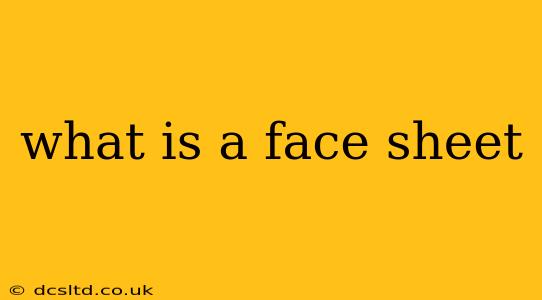A face sheet, often called a "patient face sheet" or "patient summary," is a concise, readily accessible document containing essential information about a patient. It serves as a quick reference for healthcare professionals, providing a snapshot of the patient's key details and medical history at a glance. Think of it as the first page of a patient's more extensive medical record. While the exact format can vary between healthcare facilities and electronic health record (EHR) systems, the core purpose remains consistent: to offer vital patient data in a streamlined manner.
What Information Does a Face Sheet Typically Include?
A typical face sheet generally includes the following information:
-
Demographics: This is the foundational layer, encompassing the patient's full name, date of birth, gender, address, phone number, and sometimes their social security number (though this is often restricted for privacy reasons).
-
Insurance Information: Details regarding the patient's health insurance provider, policy number, and group number are crucial for billing and administrative purposes.
-
Emergency Contact Information: Contact details for a person to be notified in case of an emergency. This often includes the name, relationship to the patient, and contact information.
-
Medical History (Summary): This section summarizes significant past medical conditions, surgeries, allergies, and current medications. It doesn't usually go into great detail, but it highlights key information for quick reference.
-
Allergies: A clearly marked list of any known allergies, including medications, food, and environmental allergens, is essential for patient safety.
-
Admission/Visit Date and Time: This is essential for tracking the patient's care timeline and hospital stays.
Why Are Face Sheets Important?
Face sheets play a vital role in ensuring efficient and safe patient care. Here's why:
-
Quick Access to Critical Information: During emergencies or when time is of the essence, a face sheet provides healthcare professionals with immediate access to the most critical patient details.
-
Improved Communication: The standardized format facilitates better communication between healthcare providers, reducing the risk of misunderstandings or missed information.
-
Streamlined Administrative Processes: Accurate face sheet information expedites billing, insurance claims, and other administrative tasks.
-
Enhanced Patient Safety: Clearly documented allergies and medical history significantly contribute to patient safety by preventing adverse reactions or treatment errors.
What is the difference between a face sheet and a medical record?
A face sheet is a summary of key information, whereas the medical record is a comprehensive and detailed account of a patient's medical history, including diagnostic tests, treatment plans, progress notes, and other clinical documentation. The face sheet serves as a quick access point to the most vital information contained within the much larger medical record.
How is a face sheet different from other patient identification documents?
While a face sheet provides identification information, it's not solely an identification document. Other patient identification documents, like driver's licenses or insurance cards, focus primarily on identity verification. A face sheet adds critical medical information for care delivery and administrative purposes.
What are the legal and ethical considerations surrounding face sheets?
Face sheets contain sensitive patient information, so strict adherence to HIPAA (Health Insurance Portability and Accountability Act) regulations and other relevant privacy laws is mandatory. Maintaining confidentiality and securing patient data are paramount responsibilities for healthcare providers.
In conclusion, the face sheet is a critical component of modern healthcare, acting as a vital bridge between patient information and efficient, safe medical care. Its concise format and readily accessible information make it an indispensable tool for healthcare professionals.
